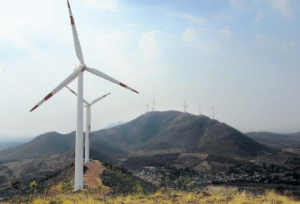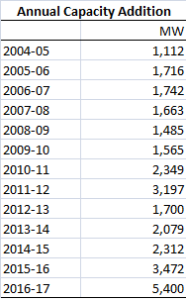 Whilst most attention in the renewable energy sector is being focused on solar energy of late, it is wind that has surprised observers with its breezing performance. The Indian wind industry has added a record 5,400 mw of new generation capacity in FY17, surpassing the target of 4,000 mw set for the year. This is the first time in history that wind power addition in a single year has breached the 5-GW mark. This feat is poised to be a big morale booster for the wind industry that is known to be caught in a web of policy uncertainties and has also been in the shadow of the more glamorous solar power sector. The previous highest addition in a single financial year by the wind power industry was 3,423 mw in FY16.
Whilst most attention in the renewable energy sector is being focused on solar energy of late, it is wind that has surprised observers with its breezing performance. The Indian wind industry has added a record 5,400 mw of new generation capacity in FY17, surpassing the target of 4,000 mw set for the year. This is the first time in history that wind power addition in a single year has breached the 5-GW mark. This feat is poised to be a big morale booster for the wind industry that is known to be caught in a web of policy uncertainties and has also been in the shadow of the more glamorous solar power sector. The previous highest addition in a single financial year by the wind power industry was 3,423 mw in FY16.
The year FY17 proved eventful for the wind industry in terms of new policy initiatives. Towards, the close of the year, the Centre embarked on tariff-based bidding, marking a significant departure from the conventional feed-in tariff mechanism. Though official results of the tender are not yet out, it is widely expected that wind tariffs would be in the region of Rs.4 per kwh, as against the feed-in tariff band of Rs.4 to Rs.6 per kwh. Initiatives were also taken with respect to new policies on re-powering (replacing existing turbines with those of higher capacity), wind-solar hybrid plants, etc.
 Returning to the performance in FY17, it is worthwhile to note that in the first nine months (April to December), saw wind power capacity addition of just 1,923 mw. This means that in the last quarter, more than 3,000 mw was added. In fact, in March 2017 alone, a little over 2,000 mw was added. This is remarkable considering that the annual average wind power capacity addition during the decade ending FY14 was under 2,000 mw.
Returning to the performance in FY17, it is worthwhile to note that in the first nine months (April to December), saw wind power capacity addition of just 1,923 mw. This means that in the last quarter, more than 3,000 mw was added. In fact, in March 2017 alone, a little over 2,000 mw was added. This is remarkable considering that the annual average wind power capacity addition during the decade ending FY14 was under 2,000 mw.
In FY17, Andhra Pradesh led the state-wise growth clocking addition of 2,190 mw. This southern state was responsible for over 40 per cent of the total capacity added in FY17. It is worth noting here that Andhra Pradesh has not been affected by the state’s bifurcation of June 2014. Most of the wind-rich regions lie in divided (new) Andhra Pradesh, while the carved-out sibling Telangana not having much resources on this count. The wind power potential of Telangana is less than 10 per cent of that in (new) Andhra Pradesh. Gujarat added 1,275 mw of new capacity in FY17 followed by Karnataka with 882 mw. These three states accounted for over four-fifths of the total added in FY17.
India’s cumulative wind power capacity is estimated to have reached around 32 GW as of March 31, 2017, making it the fourth-largest country in the world. As of end of 2016, China had an astounding 169 GW, more than twice of second-ranking USA. Germany was third with just over 50 GW.
The Indian wind industry, unlike the solar industry, benefits from a healthy indigenous production value chain. As estimated by the Union ministry of new and renewable energy in its annual report of 2016-17, India has a total manufacturing capacity of around 10 GW of wind turbines per year. There are 21 manufacturers in the country together offering 55 models up to a maximum capacity of 3 mw per turbine. The indigenization of wind turbine manufacturing in India has reached 70 per cent and the cost of Indian wind turbines is amongst the lowest in the world, the annual report observed.


